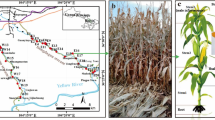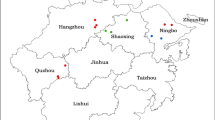Abstract
In this study, the transfer of arsenic (As) from soil to corn grain was investigated in 18 soils collected from throughout China. The soils were treated with three concentrations of As and the transfer characteristics were investigated in the corn grain cultivar Zhengdan 958 in a greenhouse experiment. Through stepwise multiple-linear regression analysis, prediction models were developed combining the As bioconcentration factor (BCF) of Zhengdan 958 and soil pH, organic matter (OM) content, and cation exchange capacity (CEC). The possibility of applying the Zhengdan 958 model to other cultivars was tested through a cross-cultivar extrapolation approach. The results showed that the As concentration in corn grain was positively correlated with soil pH. When the prediction model was applied to non-model cultivars, the ratio ranges between the predicted and measured BCF values were within a twofold interval between predicted and measured values. The ratios were close to a 1:1 relationship between predicted and measured values. It was also found that the prediction model (Log [BCF]=0.064 pH-2.297) could effectively reduce the measured BCF variability for all non-model corn cultivars. The novel model is firstly developed for As concentration in crop grain from soil, which will be very useful for understanding the As risk in soil environment.





Similar content being viewed by others
References
Adriano DC (2001) Trace elements in the terrestrial environments: biogeochemistry and risks of metals. Springer, New York, pp 47–71
Antelo J, Avena M, Fiol S, Lopez R, Arce F (2005) Effects of pH and ionic strength on the adsorption of phosphate and arsenate at the goethite-water interface. J Colloid Interface Sci 285(2):475–486
Ball DF (1964) Loss-on-ignition as an estimate of organic matter and organic carbon in noncalcareous soils. J Soil Sci 15(1):84–92
Banerjee M, Banerjee N, Bhattacharjee P, Mondal D, Lythgoe PR, Martínez M, Pan JX, Polya DA, Gir AK (2013) High arsenic in rice is associated with elevated genotoxic effects in humans. Sci Rep 3:1–8
Boekhold AE (2008) Ecological risk assessment in legislation on contaminated soil in the Netherlands. Sci Total Environ 406(3):518–522
Bolan N, Mahimairaja S, Kunhikrishnan A, Choppala G (2013) Phosphorus-arsenic interactions in variable-charge soils in relation to arsenic mobility and bioavailability. Sci Total Environ 463–464:1154–1162
Bray RH, Kurtz LT (1945) Determination of total, organic, and available forms of phosphorus in soils. Soil Sci 59(1):39–46
Bremner JM (1996) Nitrogen total methods of soil analysis. Part 3: chemical methods, American Society of Agronomy-Soil Science Society of America 1085–1121
Dave R, Singh P, Tripathi P, Shri M, Dixit G et al (2013) Arsenite tolerance is related to proportional thiolic metabolite synthesis in rice (Oryza sativa L.). Arch Environ Contam Toxicol 64(2):235–242
De Schamphelaere KAC, Heijerick D, Janssen C (2006) Cross-phylum comparison of a chronic biotic ligand model to predict chronic toxicity of copper to a freshwater rotifer, Brachionus calyciflorus (Pallas). Ecotoxicol Environ Saf 63(2):189–195
Deleebeeck NME, De Laender F, Chepurnov V, Vyverman W, Janssen CR, De Schamphelaere KAC (2009) A single bioavailability model can accurately predict Ni toxicity to green microalgae in soft and hard surface waters. Water Res 43(7):1935–1947
Ding CF, Li XG, Zhang TL, Ma YB, Wang XX (2014a) Phytotoxicity and accumulation of chromium in carrot plants and the derivation of soil thresholds for Chinese soils. Ecotoxicol Environ Saf 108:179–186
Ding CF, Zhang TL, Li XG, Wang XX (2014b) Major controlling factors and prediction models for mercury transfer from soil to carrot. J Soils Sediments 14(6):1136–1146
Ding CF, Zhou F, Li XG, Zhang TL, Wang XX (2015) Modeling the transfer of arsenic from soil to carrot (Daucus carota L.)—a greenhouse and field-based study. Environ Sci Pollut Res 22:10627–10635
Dohrmann R (2006) Cation exchange capacity methodology II: a modified silver-thiourea method. Appl Clay Sci 34(1–4):38–46
Duan G, Li W, Chen X, Hu Y, Zhu Y (2013) Association of arsenic with nutrient elements in rice plants. Metallomics 5:784–792
Fayiga AO, Ma LQ, Zhou QX (2007) Effects of plant arsenic uptake and heavy metals on arsenic distribution in an arsenic-contaminated soil. Environ Pollut 147(3):737–742
Gandoisa L, Probstb A, Dumata C (2010) Modelling trace metal extractability and solubility in French forest soils by using soil properties. Eur J Soil Sci 61(2):271–286
Goldberg S, Sposito G (1984) A chemical model of phosphate adsorption by soils. I. Reference oxide minerals. Soil Sci Soc Am J 48(4):772–778
Gustafsson JP (2006) Arsenate adsorption to soils: modelling the competition from humic substances. Geoderma 136(1–2):320–330
Islam MN, Das BK, Huque ME (2012) Arsenic accumulation in common vegetables from irrigation. J Sci Res 4(3):675–688
Jacobs LW, Syers JK, Keeney DR (1970) Arsenic sorption by soils. Soil Sci Soc Am J 34(5):750–754
Johansen A, Jensen ES (1996) Transfer of N and P from intact or decomposing roots of pea to barley interconnected by an arbuscular mycorrhizal fungus. Soil Biol Biochem 28(1):73–81
Kim Anh BT, Kim DD, Kuschk P, Tua TV, Hue NT, Minh NN (2013) Effect of soil pH on As hyperaccumulation capacity in fern species, Pityrogramma calomelanos. J Environ Biol 34(2):237–242
Lambkin DC, Alloway BJ (2003) Arsenate-induced phosphate release from soils and its effect on plant phosphate. Water Air Soil Pollut 144(1–4):4l–56l
Li ZJ, Yang H, Li YP, Long J, Liang YC (2014) Cross-species extrapolation of prediction model for lead transfer from soil to corn grain under stress of exogenous lead. PLoS ONE 9(1):e85688
Liu K, Lv JL, He WX, Zhang H, Cao YF, Dai YC (2015) Major factors influencing cadmium uptake from the soil into wheat plants. Ecotoxicol Environ Saf 113:207–213
Ma R, Shen JL, Wu JS, Tang Z, Shen QR, Zhao FJ (2014) Impact of agronomic practices on arsenic accumulation and speciation in rice grain. Environ Pollut 194:217–223
Manning BA, Goldberg S (1996) Modelling competitive adsorption of arsenate with phosphate and molybdate on oxide minerals. Soil Sci Soc Am J 60(1):121–131
McBride MB, Simon T, Tam G, Wharton S (2013) Lead and arsenic uptake by leafy vegetables grown on contaminated soils: effects of mineral and organic amendments. Water Air Soil Pollut 224:1378
Meharg AA, Macnair MR (1992) Suppression of the high affinity phosphate uptake system: a mechanism of arsenate tolerance in Holcus lanatus L. J Exp Bot 43:19–24
Rahman MA, Hasegawa H, Rahman MM, Miah MAM, Tasmin A (2008) Arsenic accumulation in rice (Oryza sativa L.): human exposure through food chain. Ecotoxicol Environ Saf 69:317–324
Ratnaike RN (2003) Acute and chronic arsenic toxicity. Postgrad Med J 79:391–396
Ravenscroft P, Mcarthur J, Hoque B (2001) Geochemical and palaeohydrological controls on pollution of groundwater by arsenic: arsenic exposure and health effects, IV. Elsevier Science Ltd., Oxford, pp 53–77
Sahoo PK, Kim K (2013) A review of the arsenic concentration in paddy rice from the perspective of geoscience. Geosci J 17(1):107–122
Schlekat CE, Genderen EV, UGent KDS, Antunes PMC, Rogevich EC (2010) Cross-species extrapolation of chronic nickel Biotic Ligand Models. Sci Total Environ 408(24):6148–6157
Smedley PL, Edmunds WM, Pelig-Ba KB (1996) Mobility of arsenic in groundwater in the Obuasi gold-mining area Ghana: some implications for human health. In: Appleton JD, Fuge R, McCall, GJH (eds) Environmental geochemistry and health. Geological Society Special Publication 113, London, pp 163–181
Sparks DL, Page AL, Helmke PA, Loeppert RH, Soltanpour PN (1996) Methods of soil anlysis. Part 3. Chemical methods. Soil Science Society of America, Inc, Madison
Steen RJCA, Leonards PEG, Brinkman UAT, Barcelo D, Tronczynski J, Albanis TA, Cofino WP (1999) Ecological risk assessment of agrochemicals in European estuaries. Environ Toxicol Chem 18(7):1574–1581
Tong J, Guo H, Wei C (2014) Arsenic contamination of the soil-wheat system irrigated with high arsenic groundwater in the Hetao Basin, Inner Mongolia, China. Sci Total Environ 496:479–487
Van Sprang PA, Verdonck FAM, Van Assche F, Regoli L, De Schamphelaere KAC (2009) Environmental risk assessment of zinc in European freshwaters: a critical appraisal. Sci Total Environ 407(20):5373–5391
Wang XQ (2012) Ecological thresholds for copper and nickel in Chinese agricultural soils. China Mining University, Beijing
Wheeler J, Grist E, Leung K, Morritt D, Crane M (2002) Species sensitivity distributions: data and model choice. Mar Pollut Bull 45(1–12):192–202
Xia YS, Chen BD, Christie P, Smthf A, Wang YS, Li XL (2007) Arsenic uptake by arbuscular mycorrhizal maize (Zea mays L.) grown in an arsenic-contaminated soil with added phosphorus. J Environ Sci 19(10):1245–1251
Yang H, Li ZJ, Lu L, Long J, Liang YC (2013) Cross-species extrapolation of prediction models for cadmium transfer from soil to corn grain. PLoS ONE 8(12):e80855
Zarcinas BA, McLaughlin MJ, Smart MK (1996) The effect of acid digestion technique on the performance of nebulisation systems used in inductively coupled plasma spectrometry. Commun Soil Sci Plant Anal 27(5–8):1331–1354
Zhang H, Zhao FJ, Sun B, Davison W, Mcgrath SP (2001) A new method to measure effective soil solution concentration predicts copper availability to plants. Environ Sci Technol 35:2602–2607
Zhao FJ, Ma JF, Meharg AA, McGrath SP (2009) Arsenic uptake and metabolism in plants. New Phytol 181(4):777–794
Zhao FJ, McGrath SP, Meharg AA (2010) Arsenic as a food chain contaminant: mechanisms of plant uptake and metabolism and mitigation strategies. Annu Rev Plant Biol 61:535–559
Zhao RX, Guo W, Bi N, Guo JY, Wang LX, Zhao J, Zhang J (2015) Arbuscular mycorrhizal fungi affect the growth, nutrient uptake and water status of maize (Zea mays L.) grown in two types of coal mine spoils under drought stress. Appl Soil Ecol 88:41–49
Acknowledgments
This work was jointly supported by the Special Projects Foundation of Beijing Municipal Sciences and Technology Commission (Project No. Z141105000614012), the Special Fund of Public Industry in China (Agriculture, project No. 200903015), and the Science and Technology project of Hebei Province (Project No. 15227504D).
Author information
Authors and Affiliations
Corresponding author
Additional information
Responsible editor: Marcus Schulz
Rights and permissions
About this article
Cite this article
Yang, H., Li, Z., Long, J. et al. Prediction models for transfer of arsenic from soil to corn grain (Zea mays L.). Environ Sci Pollut Res 23, 6277–6285 (2016). https://doi.org/10.1007/s11356-015-5851-2
Received:
Accepted:
Published:
Issue Date:
DOI: https://doi.org/10.1007/s11356-015-5851-2




